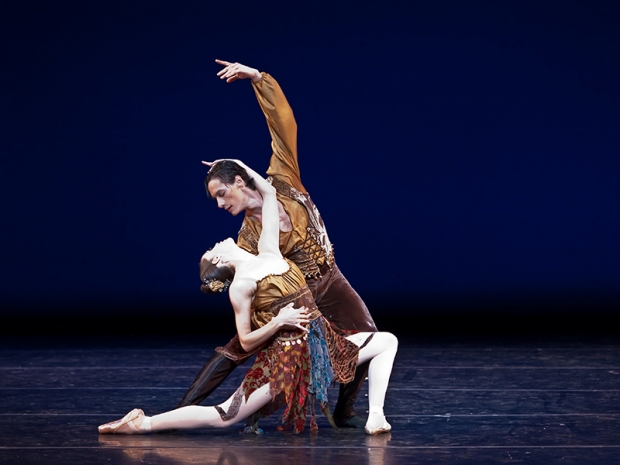 Last Saturday, I spent the day in Raleigh with my sister. We met up for a matinee performance of Carolina Ballet’s Rubies. The show was the company’s season opener and featured short pieces by George Balanchine, one of the greatest choreographers of the 20th century. Carolina Ballet’s artistic director, Robert Weiss, was once a principal dancer with the New York City Ballet, invited to join by Balanchine himself. And having the opportunity to watch Balanchine’s original choreography and vision being represented in the present day was such a treat.
Last Saturday, I spent the day in Raleigh with my sister. We met up for a matinee performance of Carolina Ballet’s Rubies. The show was the company’s season opener and featured short pieces by George Balanchine, one of the greatest choreographers of the 20th century. Carolina Ballet’s artistic director, Robert Weiss, was once a principal dancer with the New York City Ballet, invited to join by Balanchine himself. And having the opportunity to watch Balanchine’s original choreography and vision being represented in the present day was such a treat.
The show opened with Raymonda Variations. The music by Glazunov was charming, and the costumes were gorgeous. Unfortunately, the majority of the actual variations were not as impressive. I’ve always felt that Carolina Ballet seems more like a dance school, rather than a professional company. Some of its principals and soloists are amazing, but the rest almost look like amateurs, in comparison. I blame my feelings on growing up in Columbus, watching Balletmet, where each dancer is undeniably athletic, confident, and expressive. Back in Raleigh, most of the Raymonda solos, which require extra conviction due to Balanchine’s difficult choreography, turned out characterless and lackluster, and a few were even awkward. It was the pleasant group numbers by the corps that saved the beginning of the show.

The next piece was The Steadfast Tin Soldier, an adorable pas de deux, based on the the Hans Christian Andersen story and accompanied by Bizet’s delightful music. The two toys danced together, fell in love, and made cute, weird attempts to hug each other (weird because their limbs were too stiff… Because they were toys). They were a joy to watch, so when the wind finally blew the doll into the fire, the entire audience felt for the tin solider.
 Rondo alla Zingarese, an excerpt from Brahms-Schoenberg Quartet, featured by far the best music: the fourth movement of Brahms’s Piano Quartet No. 1 in G minor, nicknamed “Gypsy Rondo.” I love how the music combines the fiery passion and energy of folk with the intricacies and elegance of classical. So much emotion packed into one short work!
Rondo alla Zingarese, an excerpt from Brahms-Schoenberg Quartet, featured by far the best music: the fourth movement of Brahms’s Piano Quartet No. 1 in G minor, nicknamed “Gypsy Rondo.” I love how the music combines the fiery passion and energy of folk with the intricacies and elegance of classical. So much emotion packed into one short work!
I don’t think the dancers were quite able to keep up with the music’s dynamic spirit. But it was still fun to watch Balanchine’s choreography and the flirtatious courtship between the gypsies.
À la Françaix, a rarity that shows Balanchine’s scarcely seen humorous side, is a modern-day (for the time) parody of La Sylphide, in which a girl is jilted by her fiancé when he mysteriously meets a fairy. Yes, it’s as random as it sounds.
 This piece was less about the steps and more about the personality, and the dancers did an admirable job of exaggerating their French characters. Françaix’s Serenade provided the perfectly whimsical and ethereal accompaniment.
This piece was less about the steps and more about the personality, and the dancers did an admirable job of exaggerating their French characters. Françaix’s Serenade provided the perfectly whimsical and ethereal accompaniment.
The show ended with the title piece Rubies, taken from Balanchine’s plotless Jewels. The curtain rose above all of the dancers standing in a line, their shiny, red costumes complete with sparkling, red gems. Under the lighting, the dancers glowed like fire, and the audience couldn’t help collectively letting out ooh’s and ah’s. That first sight really was breathtaking.

Though Stravinsky was Russian, his music in this work contained much more American influences. Balanchine’s choreography here was also very American, as he incorporated jazz rhythms and abstract movement. It subtly glorified the human body’s capabilities and was absolutely luxurious to watch.
The dancers’ faces were generally stoic, but the audience could still sense their enthusiasm for the dance, probably more so than in all of the previous pieces combined. Rubies was undoubtedly the highlight of the show.
There was a food truck outside the theater, so obviously we had to stop by. Beth is going to love this candid picture of herself on the internet!
Asian-style vegetarian dumplings. Yum!
 Afterwards, we did some shopping before getting dinner at Brio, where I ordered my two favorite salads: Caprese and the Brio chopped salad. Basically, it was an all-around fabulous day!
Afterwards, we did some shopping before getting dinner at Brio, where I ordered my two favorite salads: Caprese and the Brio chopped salad. Basically, it was an all-around fabulous day!




